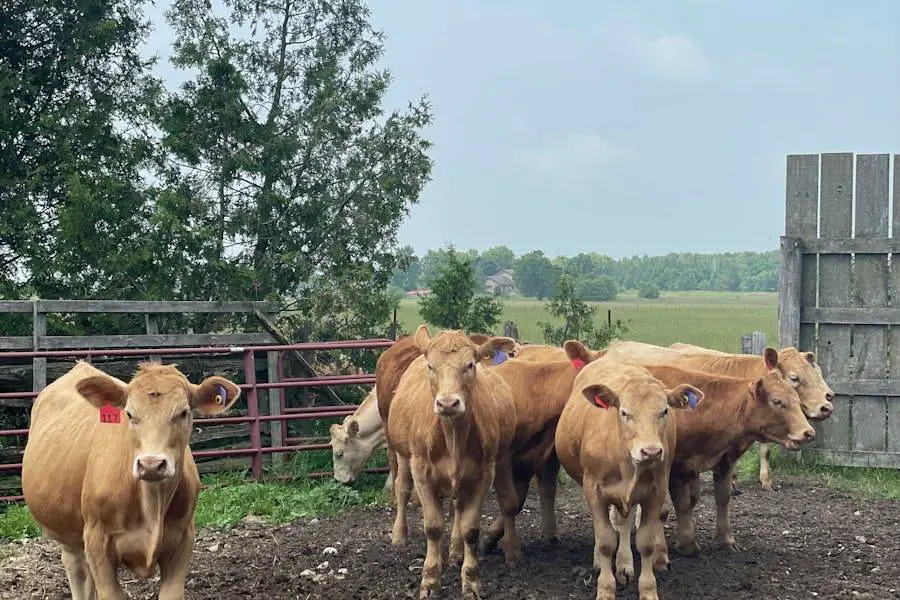Table of Contents
The occurrence of heifers breeding too early is a scenario that can lead to significant concern for farmers and cattle breeders.

Early breeding, defined as conception occurring before a heifer has reached the ideal physical or age-related maturity, presents not just immediate challenges but also long-term consequences for both the heifer and her offspring.
This article delves deep into understanding the implications of early breeding, immediate actions to be taken, monitoring and management strategies during pregnancy, the impact on long-term health and fertility, adjustments in farm management practices, and broader considerations including legal and ethical issues.
Understanding Early Breeding in Heifers
The Biology of Early Breeding
Early breeding in heifers is a complex issue rooted in biology. Heifers typically reach puberty between 6 to 12 months of age, depending on factors such as breed and nutritional status.
However, the ability to conceive does not necessarily mean they are ready for a healthy pregnancy.
Breeding before reaching 65% of their mature body weight can lead to complications due to incomplete physical development.
Potential Risks and Consequences
The risks associated with early breeding include higher rates of dystocia, which is challenging labor due to the underdeveloped pelvic area of the young heifer.
There’s also an increased risk of calf mortality and morbidity, and potential for long-term reproductive issues for the heifer herself.
Stunted growth due to the nutritional demands of pregnancy competing with the heifer’s own growth requirements is another concern.
Immediate Steps to Take When a Heifer Is Bred Too Early
When faced with a scenario where a heifer has been bred too early, it’s vital to act swiftly and decisively to mitigate potential health risks for both the heifer and her offspring.
The following comprehensive guide outlines the immediate steps that should be taken to manage this challenging situation effectively.
1. Confirm the Pregnancy
- Pregnancy Testing: The first step is to confirm the pregnancy. This can be done through various methods such as palpation, ultrasound, or blood tests, with each having its own time frame post-breeding for accurate detection.
- Timing: It’s crucial to perform the pregnancy test at the appropriate time recommended for the chosen method to ensure accuracy.
2. Veterinary Assessment
- Health Evaluation: Schedule an immediate consultation with a veterinarian. A thorough health evaluation of the heifer is necessary to understand her condition and the viability of the pregnancy.
- Risk Assessment: The vet can help assess the risks involved with carrying the pregnancy to term, considering the heifer’s age, size, breed, and health status.
- Decision Making: Based on the assessment, you may need to make tough decisions, including whether to continue the pregnancy. The vet can guide you on the best course of action for the welfare of the heifer and the calf.
3. Nutritional Support
- Dietary Plan: An early-bred heifer requires a tailored nutritional plan that supports both her continued growth and the development of the fetus. Consult with a nutritionist to adjust her diet accordingly.
- Supplements: The introduction of supplements might be necessary to meet the increased nutritional demands. This includes higher levels of protein, energy, minerals, and vitamins.
- Monitoring: Regular monitoring of the heifer’s body condition is essential to ensure she is receiving adequate nutrition and adjusting the dietary plan as needed.
4. Adjusting Management Practices

- Housing: Consider adjustments to housing to ensure the comfort and safety of the young heifer. She may require more space, softer bedding, or separation from more aggressive herd members.
- Handling: Gentle handling is crucial. Stress can adversely affect the health of the heifer and the development of the fetus. Implement low-stress handling practices to minimize any potential stressors.
5. Education and Planning
- Learning: Use this opportunity to educate yourself and your team on the implications of early breeding. Understanding the risks and management adjustments required can better prepare you for current and future incidents.
- Future Prevention: Start planning preventive measures to avoid similar situations in the future. This could involve revising breeding protocols, enhancing biosecurity measures, or improving livestock monitoring systems.
6. Emotional and Ethical Considerations
- Support: Recognize that dealing with early-bred heifers can be emotionally taxing. Seek support from fellow farmers, advisors, or mental health professionals to navigate these challenges.
- Ethical Decisions: Always prioritize the welfare of the heifer and her offspring in your decisions. Consulting with a veterinarian and considering the ethical implications of your choices is paramount.
7. Documentation and Record-Keeping
- Detailed Records: Keep detailed records of all actions taken, including veterinary visits, dietary changes, and any treatments administered. This documentation can be invaluable for managing the current situation and preventing future occurrences.
- Review and Reflect: Regularly review the records to identify any trends or areas for improvement in herd management practices.
Taking these immediate steps can help manage the complexities of a heifer bred too early, ensuring the best possible outcome for her and her offspring.
Remember, the key to navigating this challenge lies in prompt action, informed decision-making, and a commitment to the welfare of the animals under your care.
Monitoring and Managing Pregnancy
Prenatal care should be intensified for heifers bred early. This includes regular veterinary check-ups, vaccinations as recommended, and possibly supplements to support fetal development.
Monitoring for signs of distress or health issues becomes even more critical.
Preparation for calving should encompass plans for immediate veterinary assistance.
Facilities should be equipped to handle emergency deliveries, and staff should be trained to recognize the signs of labor complications early.
Long-Term Health Considerations

The repercussions of early breeding on future fertility can include irregular estrous cycles, increased difficulty in conceiving again, and potentially a shortened productive lifespan.
Monitoring and managing the heifer’s health post-calving is essential to mitigate these effects.
Implementing controlled breeding programs and ensuring heifers reach a suitable physical maturity before breeding are fundamental strategies.
Education on the risks of early breeding and establishing strict separation protocols between young heifers and bulls are also crucial.
Adjusting Farm Management Practices
Biosecurity measures, including controlled access to breeding areas and maintaining a closed herd, can reduce the risk of early breeding.
Implementing identification systems for animals of different ages and breeding status can also aid in management.
Developing clear, age-appropriate breeding protocols helps in planning the breeding season effectively.
This includes setting minimum age and weight criteria for breeding heifers and regularly reviewing these criteria based on herd performance and health outcomes.
Legal and Ethical Considerations
Awareness of local and national regulations governing livestock breeding is essential.
Compliance with these regulations ensures that breeding practices meet legal standards and protect the welfare of the animals.
Ethical considerations involve evaluating the welfare implications of breeding decisions.
Ethical breeding practices prioritize the health and well-being of the heifers and their offspring, aiming for sustainable and humane livestock management.
Conclusion
Dealing with early breeding in heifers requires a multifaceted approach, combining immediate medical care with long-term management and preventive strategies.
Understanding the biological, health, and welfare implications is key to making informed decisions that promote the well-being of both the heifer and her calf.
Through diligent care, comprehensive management practices, and a commitment to ethical standards, it is possible to navigate the challenges posed by early breeding and foster a healthy, productive livestock operation.


